Gyunam Park
INEXA: Interactive and Explainable Process Model Abstraction Through Object-Centric Process Mining
Mar 27, 2024Abstract:Process events are recorded by multiple information systems at different granularity levels. Based on the resulting event logs, process models are discovered at different granularity levels, as well. Events stored at a fine-grained granularity level, for example, may hinder the discovered process model to be displayed due the high number of resulting model elements. The discovered process model of a real-world manufacturing process, for example, consists of 1,489 model elements and over 2,000 arcs. Existing process model abstraction techniques could help reducing the size of the model, but would disconnect it from the underlying event log. Existing event abstraction techniques do neither support the analysis of mixed granularity levels, nor interactive exploration of a suitable granularity level. To enable the exploration of discovered process models at different granularity levels, we propose INEXA, an interactive, explainable process model abstraction method that keeps the link to the event log. As a starting point, INEXA aggregates large process models to a "displayable" size, e.g., for the manufacturing use case to a process model with 58 model elements. Then, the process analyst can explore granularity levels interactively, while applied abstractions are automatically traced in the event log for explainability.
Analyzing An After-Sales Service Process Using Object-Centric Process Mining: A Case Study
Oct 16, 2023Abstract:Process mining, a technique turning event data into business process insights, has traditionally operated on the assumption that each event corresponds to a singular case or object. However, many real-world processes are intertwined with multiple objects, making them object-centric. This paper focuses on the emerging domain of object-centric process mining, highlighting its potential yet underexplored benefits in actual operational scenarios. Through an in-depth case study of Borusan Cat's after-sales service process, this study emphasizes the capability of object-centric process mining to capture entangled business process details. Utilizing an event log of approximately 65,000 events, our analysis underscores the importance of embracing this paradigm for richer business insights and enhanced operational improvements.
Extracting Rules from Event Data for Study Planning
Oct 04, 2023Abstract:In this study, we examine how event data from campus management systems can be used to analyze the study paths of higher education students. The main goal is to offer valuable guidance for their study planning. We employ process and data mining techniques to explore the impact of sequences of taken courses on academic success. Through the use of decision tree models, we generate data-driven recommendations in the form of rules for study planning and compare them to the recommended study plan. The evaluation focuses on RWTH Aachen University computer science bachelor program students and demonstrates that the proposed course sequence features effectively explain academic performance measures. Furthermore, the findings suggest avenues for developing more adaptable study plans.
Preventing Object-centric Discovery of Unsound Process Models for Object Interactions with Loops in Collaborative Systems: Extended Version
Mar 31, 2023Abstract:Object-centric process discovery (OCPD) constitutes a paradigm shift in process mining. Instead of assuming a single case notion present in the event log, OCPD can handle events without a single case notion, but that are instead related to a collection of objects each having a certain type. The object types constitute multiple, interacting case notions. The output of OCPD is an object-centric Petri net, i.e. a Petri net with object-typed places, that represents the parallel execution of multiple execution flows corresponding to object types. Similar to classical process discovery, where we aim for behaviorally sound process models as a result, in OCPD, we aim for soundness of the resulting object-centric Petri nets. However, the existing OCPD approach can result in violations of soundness. As we will show, one violation arises for multiple interacting object types with loops that arise in collaborative systems. This paper proposes an extended OCPD approach and proves that it does not suffer from this violation of soundness of the resulting object-centric Petri nets. We also show how we prevent the OCPD approach from introducing spurious interactions in the discovered object-centric Petri net. The proposed framework is prototypically implemented.
Performance-Preserving Event Log Sampling for Predictive Monitoring
Jan 18, 2023Abstract:Predictive process monitoring is a subfield of process mining that aims to estimate case or event features for running process instances. Such predictions are of significant interest to the process stakeholders. However, most of the state-of-the-art methods for predictive monitoring require the training of complex machine learning models, which is often inefficient. Moreover, most of these methods require a hyper-parameter optimization that requires several repetitions of the training process which is not feasible in many real-life applications. In this paper, we propose an instance selection procedure that allows sampling training process instances for prediction models. We show that our instance selection procedure allows for a significant increase of training speed for next activity and remaining time prediction methods while maintaining reliable levels of prediction accuracy.
Explainable Predictive Decision Mining for Operational Support
Oct 30, 2022



Abstract:Several decision points exist in business processes (e.g., whether a purchase order needs a manager's approval or not), and different decisions are made for different process instances based on their characteristics (e.g., a purchase order higher than $500 needs a manager approval). Decision mining in process mining aims to describe/predict the routing of a process instance at a decision point of the process. By predicting the decision, one can take proactive actions to improve the process. For instance, when a bottleneck is developing in one of the possible decisions, one can predict the decision and bypass the bottleneck. However, despite its huge potential for such operational support, existing techniques for decision mining have focused largely on describing decisions but not on predicting them, deploying decision trees to produce logical expressions to explain the decision. In this work, we aim to enhance the predictive capability of decision mining to enable proactive operational support by deploying more advanced machine learning algorithms. Our proposed approach provides explanations of the predicted decisions using SHAP values to support the elicitation of proactive actions. We have implemented a Web application to support the proposed approach and evaluated the approach using the implementation.
A Framework for Extracting and Encoding Features from Object-Centric Event Data
Sep 02, 2022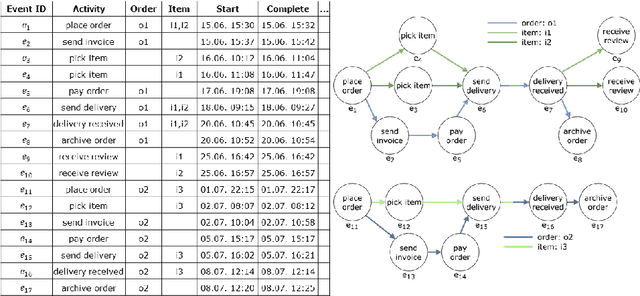

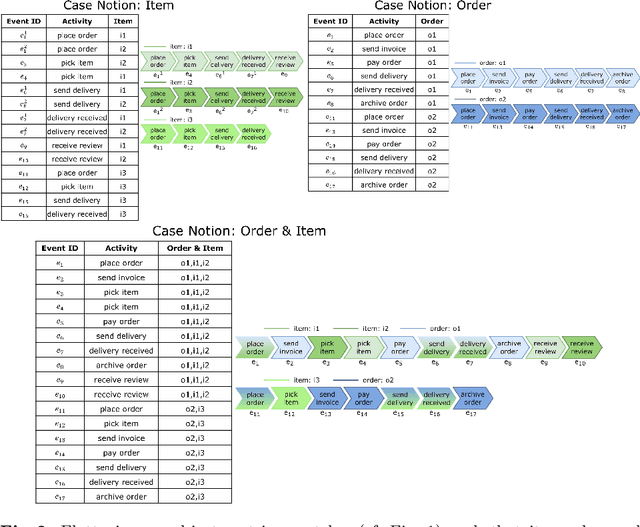
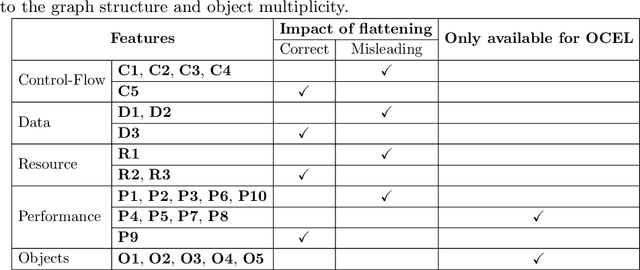
Abstract:Traditional process mining techniques take event data as input where each event is associated with exactly one object. An object represents the instantiation of a process. Object-centric event data contain events associated with multiple objects expressing the interaction of multiple processes. As traditional process mining techniques assume events associated with exactly one object, these techniques cannot be applied to object-centric event data. To use traditional process mining techniques, the object-centric event data are flattened by removing all object references but one. The flattening process is lossy, leading to inaccurate features extracted from flattened data. Furthermore, the graph-like structure of object-centric event data is lost when flattening. In this paper, we introduce a general framework for extracting and encoding features from object-centric event data. We calculate features natively on the object-centric event data, leading to accurate measures. Furthermore, we provide three encodings for these features: tabular, sequential, and graph-based. While tabular and sequential encodings have been heavily used in process mining, the graph-based encoding is a new technique preserving the structure of the object-centric event data. We provide six use cases: a visualization and a prediction use case for each of the three encodings. We use explainable AI in the prediction use cases to show the utility of both the object-centric features and the structure of the sequential and graph-based encoding for a predictive model.
Detecting Context-Aware Deviations in Process Executions
Jun 11, 2022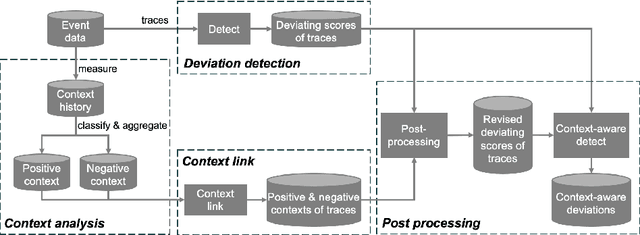

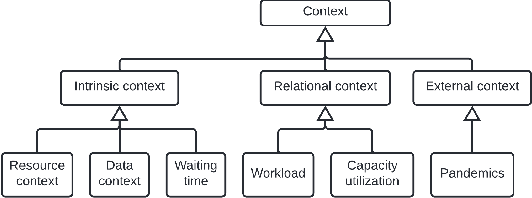
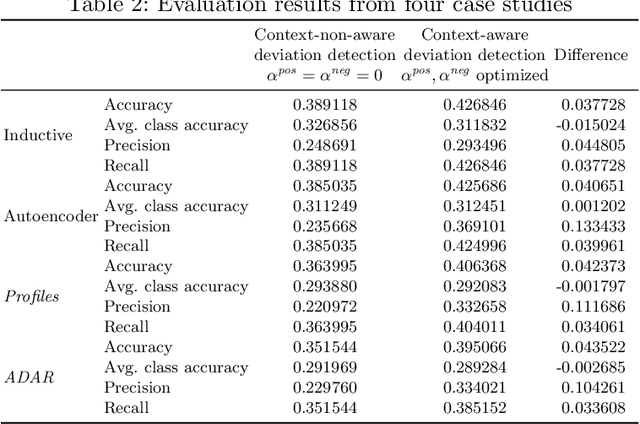
Abstract:A deviation detection aims to detect deviating process instances, e.g., patients in the healthcare process and products in the manufacturing process. A business process of an organization is executed in various contextual situations, e.g., a COVID-19 pandemic in the case of hospitals and a lack of semiconductor chip shortage in the case of automobile companies. Thus, context-aware deviation detection is essential to provide relevant insights. However, existing work 1) does not provide a systematic way of incorporating various contexts, 2) is tailored to a specific approach without using an extensive pool of existing deviation detection techniques, and 3) does not distinguish positive and negative contexts that justify and refute deviation, respectively. In this work, we provide a framework to bridge the aforementioned gaps. We have implemented the proposed framework as a web service that can be extended to various contexts and deviation detection methods. We have evaluated the effectiveness of the proposed framework by conducting experiments using 255 different contextual scenarios.
OPerA: Object-Centric Performance Analysis
Apr 22, 2022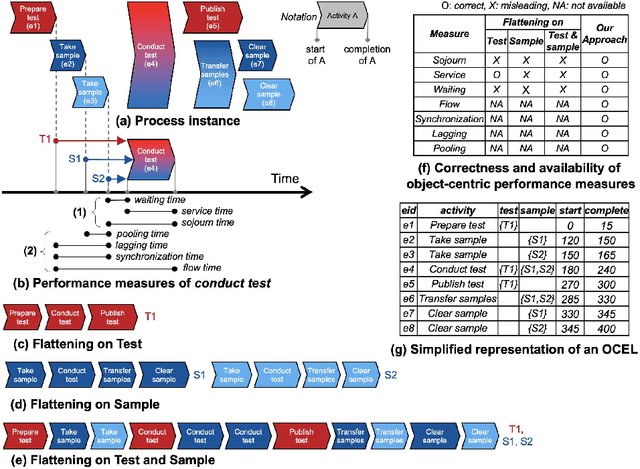
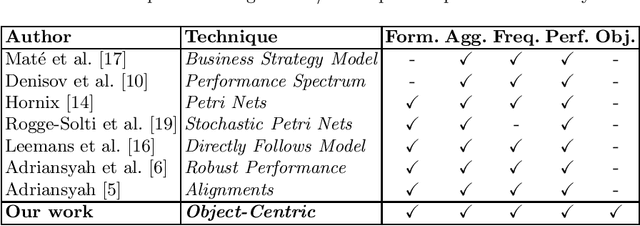

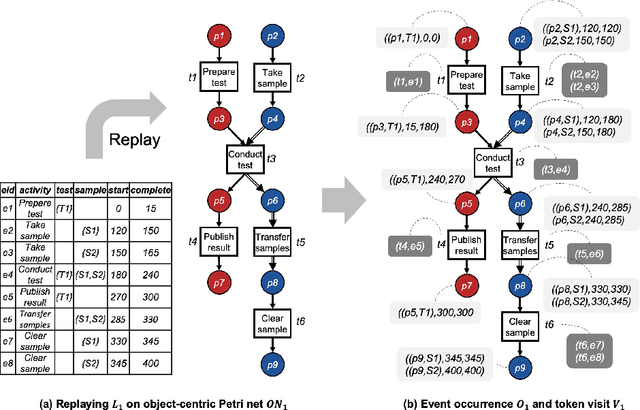
Abstract:Performance analysis in process mining aims to provide insights on the performance of a business process by using a process model as a formal representation of the process. Such insights are reliably interpreted by process analysts in the context of a model with formal semantics. Existing techniques for performance analysis assume that a single case notion exists in a business process (e.g., a patient in healthcare process). However, in reality, different objects might interact (e.g., order, item, delivery, and invoice in an O2C process). In such a setting, traditional techniques may yield misleading or even incorrect insights on performance metrics such as waiting time. More importantly, by considering the interaction between objects, we can define object-centric performance metrics such as synchronization time, pooling time, and lagging time. In this work, we propose a novel approach to performance analysis considering multiple case notions by using object-centric Petri nets as formal representations of business processes. The proposed approach correctly computes existing performance metrics, while supporting the derivation of newly-introduced object-centric performance metrics. We have implemented the approach as a web application and conducted a case study based on a real-life loan application process.
Event Log Sampling for Predictive Monitoring
Apr 04, 2022

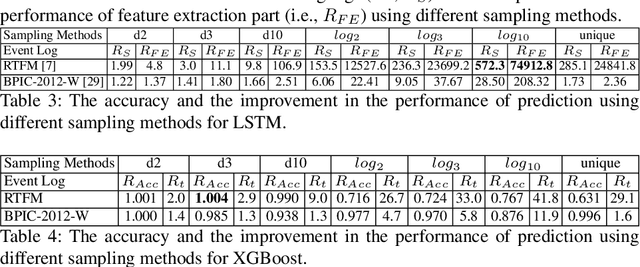

Abstract:Predictive process monitoring is a subfield of process mining that aims to estimate case or event features for running process instances. Such predictions are of significant interest to the process stakeholders. However, state-of-the-art methods for predictive monitoring require the training of complex machine learning models, which is often inefficient. This paper proposes an instance selection procedure that allows sampling training process instances for prediction models. We show that our sampling method allows for a significant increase of training speed for next activity prediction methods while maintaining reliable levels of prediction accuracy.
* 7 pages, 1 figure, 4 tables, 34 references
 Add to Chrome
Add to Chrome Add to Firefox
Add to Firefox Add to Edge
Add to Edge